#anyhow this was fun
Explore tagged Tumblr posts
Text
hi! ok so i'm going to talk about one of my top-five favourite things, which is: dyeing stuff! this is going to be specifically about dyeing protein fibres (animal fibres—wool, alpaca, silk, etc) in a pretty low-key way in your kitchen.
to be clear up front: this is not the most scientific, most perfectly reproducible, or most Objectively Correct way to dye things. i get a lot of fibre that i like this way, though, and i think that other people can, too.
fibre i've dyed that i think is neat:
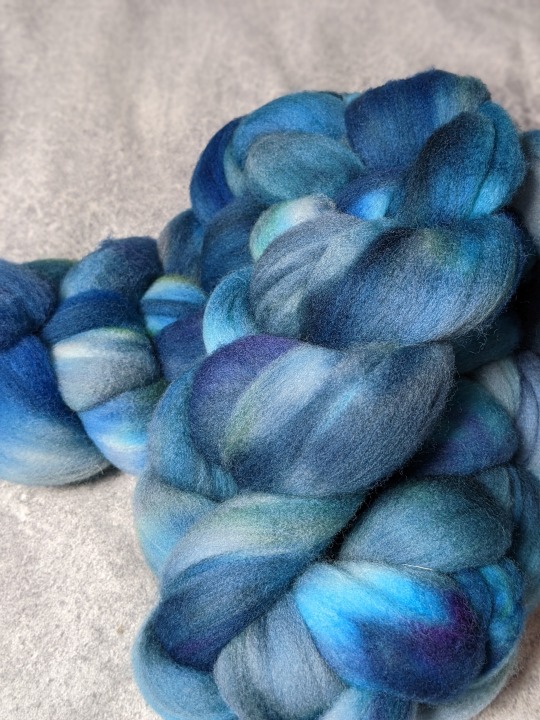


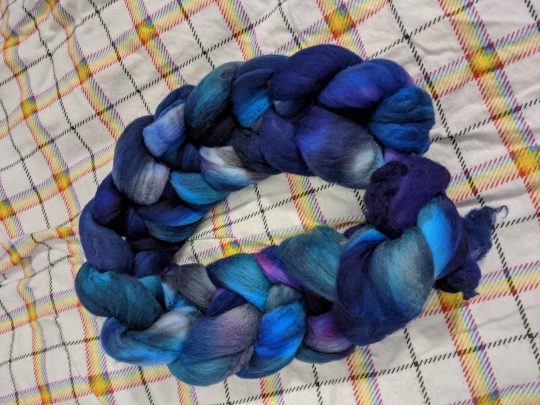
you can also dye yarn like this:
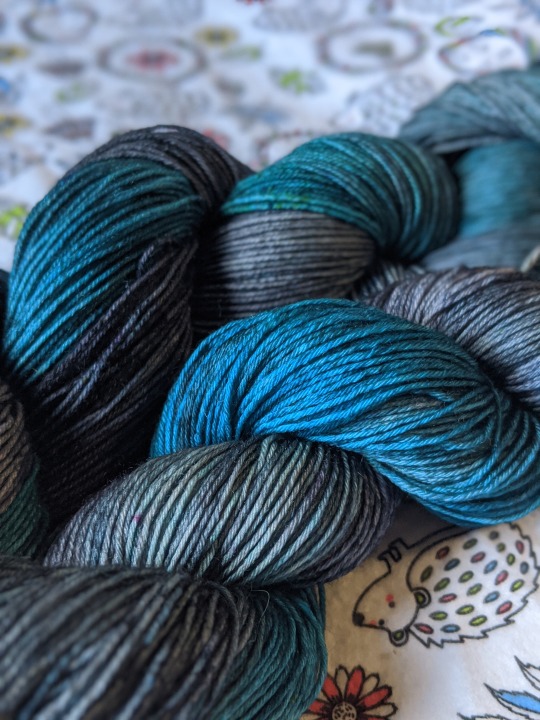
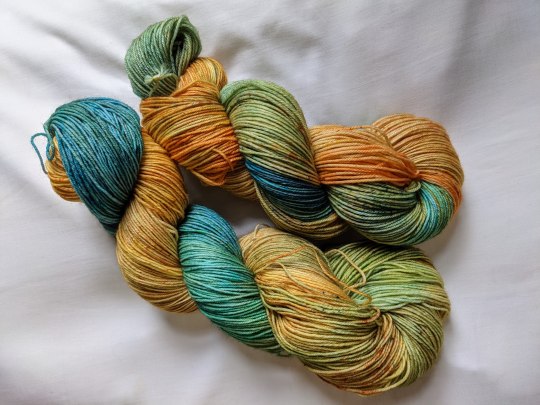
yes, i like blue a lot. i also really like variegation and heathering, which is why most of the fibre here has patches of white—it's an intentional choice that i've made. you can make different choices.
here is what you need to dye things:
fibre, vinegar, dye, a pot, heat, and some water.
that was so you don't get overwhelmed by the impending wall of text. here is what you need to dye things (it's the same stuff!), but with way more detail:
fibre or yarn. this is the big one, obviously. i tend to dye in 100-200 gram batches, because that's approximately what fits on my stovetop easily. if you're very nervous about felting or harming your fibre, you can use stuff that's been treated to be superwash, start with yarn (which is harder to felt than fibre is), or use a felt-resistant breed like dorset or suffolk. honestly, though, i learned with merino because that's what i had, and it was fine. again, though, this guide is only for protein fibres. it will not work for things like cotton. the only exception to this is nylon, which will take on some colour, but less than a protein fibre will.
a mordant. this is a fancy way of saying a thing that makes dye stick, and for what we're doing here, it's citric acid or vinegar. your grocery store definitely has at least one of them, though if you can choose, i prefer citric acid, because i love wet wool smell but i do not always love wet wool vinegar smell.
dye. i use acid dyes, and am personally deeply loyal to dharma acid dyes, but ashford and jacquard acid dyes work the same way. if you don't want to buy dye or don't have access to it, food colouring will often work, as well, though i haven't tried this with natural food colourings and have no idea how well they'll work.
a dedicated dye pot. ok, if you're doing food dyes, you don't need this. if you're not, it's definitely best practice, though i don't know how dangerous it is not to. any large metal pot will do, but my favourite option is hotel pans, which are those huge metal pan/tray things that hold food at buffets and the like. i have a full-size one that's 15cm deep, and a half-size one that's 4cm deep. they're great because they let you lay out the fibre you're working with so you can see most of it in a single layer.
dedicated dye utensils. as before, i don't know how much of a huge deal this is. i'll be honest and admit that for several years i had a single pair of tongs that got used for all tong-requiring events, including dyeing, and i'm still alive. i suggest that you have at least a big spoon, and a big spoon and tongs are even better.
something to mix the dye in. yeah, i use empty plastic sports drink or soda bottles for this. you can be fancy and get mason jars or little squirt bottles or whatever, and if you get super into dyeing you'll want to mix up dye stocks, but that's way outside the scope of what we're doing here. i like the powerade bottles that have a little squirty mouthpiece, because it's fun to squirt dye onto things.
personal protective equipment. i think this is the part of things that freaks people out. ideally, you wear plastic gloves and a mask (yeah, like your covid masks) when you're working with dye. realistically, i almost never remember to put on gloves and just accept that my hands are going to be blue sometimes. you should wear a mask, because dye is an irritant, but the world is an imperfect place and i have wicked bad adhd and sometimes i forget. this isn't advice. i'm just being honest. you should use some kind of safety stuff. you probably won't die if you don't.
you might also want some little random bits: an old toothbrush or paintbrush, a pipe cleaner, some toothpicks, etc. this is mostly if you like speckles, or if you want very small patches of colour.
so first: there are a million ways to dye things, and i'm not convinced that any of them are objectively correct. i do what i do and it works for me. some of the things i do are the opposite of what most guides suggest, but i do them because i like the effects they create.
ok, that's all the background stuff you need. let's dye some stuff!
the number one most important thing to remember when you're dyeing is this:
you can always add more colour. you cannot take it away.
that's in fancy writing and bold because every once in a while i forget this, and every single time i end up regretting it.
here is how to dye things:
put water, citric acid (or vinegar), and fibre into a pot. add dye and heat. let cool completely. rinse the fibre in cool water, then hang to dry.
like, sure, we're going to go into way more detail, but push come to shove, if you do that, you're going to end up with dyed fibre. there are a lot of tutorials telling you that you must soak your fibre first, or you must add your citric acid this way, or hold the water at exactly this temperature, and i'm here to tell you that while any of these things can give you different results, those results aren't necessarily better.
the only way that you can totally screw this up is by accidentally felting your fibre, so before i get into the way more detail part of things, i'm going to talk about that.
how not to felt your fibre
i feel like if you've read this far, you know how things felt: wool, heat, and agitation. you may also notice that at least two of these things are required for dyeing. this can be stressful! but you don't have to be afraid of it. there's only been one time that i felted something to the point that it was unusable, and that happened because i literally fell asleep for several hours while the pot was on the stove. you can avoid doing this by simply setting an alarm—this is a good idea anyhow, because you'll want to check on your dye pot!
when you're dyeing, use the lowest heat that you can while still keeping the water at a simmer. if your stove, like mine, has one burner that's wildly unpredictable and sort of out of control, you may want to look for some sort of flame diffuser, also called a flame tamer or a simmer ring. i bought one on amazon for about fourteen dollars, and it's literally just a thick metal circle. it works fine.
you can also keep the heat low by using a pot with a thick bottom, though in my experience those are expensive, and if i had one i would be using it for soup, not wool.
avoid shocking your wool—never put room temperature wool into hot water, and never put hot wool into cold water. leave your wool in the dye bath until it's cooled completely, which for me usually means overnight.
finally, obviously you have to move the fibre around some. you'll need to peek under it in the pan, and when you're done, you have to rinse it and squish out the water. try to minimise handling, though. don't run water directly onto the fibre, don't get a wooden spoon and stir your dye pot around, don't wring the fibre dry when it's done.
you're probably never going to be perfect. i often find that i lose a gram or two of wool where fibres have grabbed onto each other, or where parts of the ends clumped up. it's not really felted, just sort of compacted, but it's not great to work with, and i'd rather lose a gram of fibre than fuss with the clumpy bits.
back to how to dye things
let's take it step by step, assuming a hundred grams of fibre.
put your pan on the stove and fill it halfway with water. add either a teaspoon of citric acid or a tablespoon of vinegar. this is going to help the dye strike, or stick to the fibre. the teaspoon/tablespoon is a guideline, but one that it's fine to exceed. adding more will help the dye strike faster, which can be useful if you're trying to create blocks of colour on your fibre. i usually err on the side of a little more than the guidelines, and just eyeball this—if you feel like the dye isn't taking well, you can add more later.
add your fibre to the pan. this is the first place you have to think about what you want the finished fibre to look like! you can put it into the pan any way you want, but i suggest trying to keep it in a relatively even layer, regardless of what that layer looks like. here are some ways to get specific effects:
if you want a gradient from one end of the fibre to the other, use a rectangular pan and lay your fibre out so that the line of it is parallel to the short sides of the pan
if you want a short, repeating gradient, use a rectangular pan and lay your fibre out so that the line of it is parallel to the long sides of the pan
if you want something that starts with very close repeats that get further apart as you go down the fibre, make an approximate spiral
if you don't want A Pattern (i usually don't) just lay things out in a single layer, more or less
here comes the next exciting part! decide if you want to let your fibre soak or not. again, doing or not doing this gives you some different effects!
soaking your fibre will mean that dye takes more evenly. if you want consistent colours, you'll want to soak.
not soaking your fibre means that the dye takes less evenly. the fibre on top will have less acid available to it, spends less time in the dye bath, and also has to actually get wet before it will start to dye. i actually love doing this, and think it affords a lot of cool opportunities to play with and layer colours.
if you're soaking, leave the fibre there until it's submerged. if not, don't.
now you're going to add dye! decision time, again.
you can add dye when the water is cold, which will give you more even dye coverage, and in my experience gives the colours more time to mix together
you can add dye when when the water is hot, which will give you less even coverage, and tends to encourage the colours to stay more delineated
probably surprising no one, i tend to heat the water first unless i'm starting with a base colour or i'm doing a two-colour gradient.
time to mix up some dye
as i mentioned earlier, i'm assuming that you're using powered acid dyes for this. if you're not, this mixing up part is technically optional—but doing it gives you way more control about how and where you place your colours, so i'm going to assume that you'll do it.
i usually mix dye in some sort of empty drink bottle. regardless of what you're using, before you add dye to anything, put some water in the bottle, wipe off the lip, put the lid on tightly, and shake the bottle vigorously. if there is any leakage at all, do not use that bottle. find a better bottle. if your bottle cap doesn't seal well or if you have an empty condiment bottle that's just a little wonky or whatever, you will get dye all over the kitchen, and your landlord will be really really mad about it, and you will regret your life choices. (if you own your kitchen, you can do whatever you want, but this isn't about you and you know it.)
so you have a bottle that seals tightly! great job. dump out the water and carefully put some dye powder into the bottle. remember earlier how i said you should be wearing a mask? this is the part where you should be wearing a mask.
i know that people are reading this and going, ok, but how much dye do i put in?
my answer is put in the amount that feels right in your heart, and don't forget the number one rule of dyeing things, which is that you can always add more colour, but you cannot take it away.
this isn't a very scientific answer. most dyes have a guideline about how much to use, expressed as a percentage of the dry weight of the fibre, which is what you use to get the whole quantity of fibre dyed evenly. for dharma dyes, it's like 1.5-2%, i think ashford is 1%, and jacquard is more like 2-4%, depending on the colour.
here is the problems with doing that in your kitchen: first, using that much dye will get you an evenly dyed piece of fibre, which—for me, at least—is basically the opposite of what i want. second, and more importantly, unless you have one of those teeny tiny scales used by jewelers and drug dealers, your kitchen scale will not weigh out such tiny quantities with any accuracy. third, if you do it like this, you really have to plan what you're doing ahead of time, because there's a point after which no more dye will bind! the fibre will be like enough thank u that's it i'm good and that'll be it, so you lose some of your ability to decide that actually, you want more green.
you can probably guess, at this point, that i don't weigh the dye. once you've done a couple batches of fibre with a given brand of dye, you'll start to get the vibes for how much you should use. if you really want a guideline, for a hundred grams of fibre, start with a quarter teaspoon of a given colour. you can add more—either more of this colour or a different one—later, as desired.
put your dye in the empty bottle, and then fill the bottle partway with hot water. the amount of water doesn't really matter here, nor does the specific temperature of the water. i usually fill about 3/4 of the way, because that way there's plenty of room for this next step, which is: wipe the lip of the bottle, recap it tightly, and then shake it up real good. the dye powder is going to dissolve into the water, and you now have a bottle of dye!
if you're going for a gradient, you might want to mix up your second colour so you can add them at (basically) the same time for more even mixing. if you're not, or if you only have one mixing bottle, you can do them one at a time.
oh my god we're finally putting dye on the fibre
are you ready? it's time!!
you have basically infinite options for how to do this, and many of them will give you different effects. here are some ideas:
pour the dye all at one side of the pan. and if you don't add anything else, your fibre will fade from the colour of the dye to the natural colour of the fibre
pour two colours, one at either side of the pan. depending on how much dye you use (and remember, you can always add more), this will give you either chunks of colour surrounded by white, or a two-colour gradient
add all the dye to unheated water and mix it gently, then let the fibre soak for a few minutes longer before turning on the heat. this will give you a fairly even colour
pour randomly all over, and you'll either end up with a tonal yarn or a heathered one, depending on how much dye you're using
add the dye to the water under the dry fibre, which will sink in and take up more dye on the bottom of the fibre than the top
if your heat wasn't on before, it should be now, and you're going to let the dye hang out in the hot but not boiling water for a while. how long? well, one of the cool things about dyeing with these dyes is that they exhaust, which means that when the dye has been sucked up by the fibre, the surrounding water will be clear. how long this takes will depend on the specific dye, how much of it you used, how much mordant you used, etc. i try to check every fifteen minutes.
reminder: if you started with room temperature water, the dye's not going to start taking until the water heats up, so don't check it after fifteen minutes and freak out that nothing has happened. it is fully normal for it to take up to an hour for the dye to exhaust. don't turn up the temperature, just give it time.
yay it worked!
at this point, you have a pot of hot water with some beautifully coloured fibre in it! but maybe it's not beautiful enough. maybe you want...more colours.
that's cool as hell and you should go for it. we mentioned two-colour gradients up there, but what if you want something else?
the answer, probably obviously, is adding more dye.
first, a caveat: while you can successfully make multicoloured gradients like this, it's more difficult than you think, and if it gets messed up—all the colours bleed into each other, say—it turns into a muddy mess. my suggestion is to stick to two (or three at most!) colour gradients until you have a much better feel for what you're doing.
let's talk about ways you can add more colour. you have two options: big colour and little colour.
big colour is going to add a lot of colour—you're going to mix up the dye and pour it just like you did before, but paying more attention to places that don't have dye yet. sometimes it's the middle of a gradient, or the white splotches from random pouring, or the half of the fibre that wasn't submerged when you started. or maybe you dyed the whole thing yellow, and now you want to add a blue gradient over top. whatever!
if you don't want to freehand pour, consider buying a couple large syringes, or a bottle with a squeezy top. these are also fun because you can easily get more colour between the laid-out fibre, or even under it.
in the pictures at the start of this post, the red-and-gold top and both yarns were dyed by adding big colour.
little colour isn't going to add big patches, but is going to add speckling, tonal depth, or smaller patches of colour. all of the blue-base fibres and the yellow-and-blue yarn were dyed like this.
if you're still reading this closely, you might have caught that i just said both yarns were dyed with big colour, and that the yellow-and-blue yarn was also dyed with little colour. these are both true! the base colours of the yarn were done to make big colour, but if you look at the full-size image, there are also a bunch of speckles. you can do whatever you want! no one can stop you!
here are some ways to add little colour:
mix up some dye, but use less water. add drops of the dye, either directly onto the fibre (more dramatic!) or in the water (tonal!)
use a toothpick to grab a little bit of dye powder and drop it into the dye bath (similar to the previous one, but a little less predictable)
put on a damn facemask. take a clean toothbrush, paintbrush, or pipecleaner, and just barely touch it to the dye powder. gently flick or tap the brush to add speckles of that colour
find a salt shaker that you're never going to use for anything but this. put citric acid, salt (to make it distribute better), and dye powder into it, and shake it up (with the holes covered, please cover the holes) to make sure they're evenly distributed. gently shake this over the fibre to add speckles, but more of them, and clustered together
put a little dye in a spray bottle and gently mist the exposed fibre, kinda glazing it with colour
another thing is that if you like a natural coloured yarn with dyed speckles, you can do any of these techniques without doing big colour first. the only thing to note when doing this is that you'll want to be very sure to spread out the fibre well, and maybe to consider dyeing one side, then very very carefully flipping it over and getting the other side.
ok, now what?
let's say that you've added all the colours that you want, and you've let your bath simmer long enough that the water is clear, or nearly clear. (if it's not, check troubleshooting, below.)
put the lid on your pan and walk away. if you don't have a lid, just walk away, but it's less dramatic.
the super frustrating part here is that the safest thing to do is wait until the water and fibre is fully cooled before you do anything else.
have i ignored this? yes
has it ever gone horribly wrong? not horribly wrong, but it's definitely caused me to lose an inch or two of roving on occasion
is it way more stressful if you don't wait? absolutely yes
honestly maybe just go to bed and deal with your fibre in the morning
so now let's say that it's morning and you slept long enough that your water and fibre are both room temperature, which often actually feels quite cool on your hands.
you have to drain your fibre. there are two ways to do this:
lift the fibre out of the water. this has the upside of not risking dumping your beautiful fibre into your sink, and not needing to maneuver a full pot of water, both of which are admirable. the downside is that wet fibre is fragile, and you'll want to be careful to support it.
dump the water out of the pan. this has the upside of minimising how much handling you're doing of the fibre, as well as (in my opinion) making rinsing easier. the downside is attempting to keep the fibre into the pot while you dump the water into the sink, and also needing to carry around a full pot of water.
secret third option: dump the fibre (and the water) into a strainer. upside: very easy, and you can keep the fibre in the strainer while you rinse, minimising both how much it needs to be handled and the weight on the fibre. downside: i never remember that this is an option until i'm already elbows-deep in acidulated water, discovering every tiny cuticle tear.
you're going to fill your dyepot with water again so that you can rinse the fibre. you want to minimise thermal shock, so keep the water temperature as close to the temperature of the fibre as you can, and don't run the water directly onto the fibre. i like to pull all the fibre to one side of the pan, and fill the pan on the other side.
side note: if you, smart person, remembered that you can use a colander, simply fill a pot with water, put the colander in the pot, and gently agitate the colander.
if you, person who is deeply relatable, did not remember you can use a colander and now have a pot with clean water and fibre, gently move your fibre in the water to encourage any excess dye and also citric acid to get out of there.
drain your fibre again, and this time, you're going to squeeze it dry. you're still trying to minimise agitation, so this isn't a 'wring it out' situation, it's a 'gently squish it between your hands and/or a hand and the side of the pot' situation.
hang your fibre to dry. remember what i was saying earlier about it being fragile? let me suggest, here, that you do not simply drape the entire length over a single hanger or something and hope for the best. if you literally have a single hanger, at least drape it back and forth a bit, but better if you can use more than one hanger, or a clothes drying rack, or that weird metal wine rack thing that came with your fridge that you've never used, or whatever.
important reminder: drip-drying things will make your floor wet! if you live somewhere very clear with no major roads or pollen nearby, you can probably dry things outside, but if you don't, you'll probably want to position the drying rack in a bath, shower, laundry area, or otherwise over something that will catch and/or absorb the water.
how long it takes for the fibre to dry is another unknowable variable. if it's warm and dry where you are, it might literally be overnight. if it's damp and cool, it can take days. the batch i posted a couple days ago literally took almost a full week to dry. spread it out as best you can, gently squeeze out the water you can, and otherwise you just have to wait.
you're done!
when it's dry, that's it, you're done! you might find that you need to pick off some little lint balls or a bit of compacted or slightly felted fibre from the tips, but other than that, you should be good to go.
like most fibre stuff, this is best maintained by handwashing in cool water. you may see a little bit of dye or colour loss the first time you wash it, which is pretty normal and nothing to worry about.
congratulations! you made it to the end of this incredibly long post, and if you followed along, you've just dyed some fibre!
troubleshooting
this isn't dyed enough! i want more colours!
add more dye! i'm not the boss of you.
this is true even after the fibre is all done and dryed. there's nothing that says you can't dye it again—you can, and i have.
some fibre seems to require more dye than others. silk, for example, dyes beautifully with acid dyes, but also needs way more dye than i expect it to.
remember that if you're dyeing something that's a wool/cotton blend, for example, the cotton isn't going to dye. the only exception is nylon, which will kinda dye, but not as dramatically. this guide will not work for plant fibres.
this is too dyed! i want fewer colours!
please refer back to the number one most important thing about dyeing, which—as you know—is: you can always add more colour, but you cannot take it away.
pull out some more fibre and try again. this has a learning curve, just like any other fibre craft.
these colours don't look like i expected!
this can be about a lot of things.
colour guides, especially if you're looking at them online, aren't always very accurate.
colour guides tend to assume that you're dyeing a single colour at the suggested dye percentage of weight, and using less than that will give paler colours.
dyes, especially if you're mixing brands, can interact with each other and behave in ways you didn't expect.
dyes can also break, which is when they split into their component colour molecules. this happens commonly with blacks and browns, food colouring, and anything that dharma trading has marked as 'advanced'. some people find this very desirable and seek it out; some people are very frustrated by it.
the ph of your water can sometimes affect your dye. i've been lucky enough that i've only lived places with lead problems, not weird ph stuff, so i haven't investigated this closely, but if you're consistently not getting the results you expect, even going for a single, solid-colour dye, look at the ph.
my dye water's not clear!
if you used a quarter teaspoon of dye and a hundred grams of fibre, and it's been, say, 45 minutes of actually hot water and your water still isn't clear, you probably didn't use enough mordant, and you should add some more citric acid or vinegar to encourage the dye to get in there and do its thing.
if you used you used more like a teaspoon of dye, or if the citric acid doesn't change anything, you used too much dye for your fibre. you can either shrug and pour it down the drain, or you can add some more fibre and dye that, too.
my rinse water's not clear!
you probably used too much dye. it's ok—just keep rinsing it, gently, until it's more or less clear.
some colours just like to run—you know how every once in a while you get a yarn and it just bleeds a little bit every time you wash it? sometimes it's just like that. i wouldn't worry about it too much.
my fibre has felty/clumpy bits!
a little bit of this is normal, especially at the ends of a fibre that felts easily (this means you, merino!)
pick off the bits that you don't like—this is generally fairly easy, and involves very minimal fibre loss. i don't bother doing it until i sit down to spin, and then just pull off bits as i come to them.
if there's a lot of felty/clumpy bits, more than you can reasonably pick out, you agitated the fibre too much. there's not much for this other than trying to card it out, which may or may not work.
sometimes this happens because your stove got weirdly aggressive and boiled your fibre. especially for wool that's prone to felting, the bubbling and jostling can be enough to encourage more clinginess than you'd like.
i want my dyeing to be reproducible!
this is kinda doable. it's a handmade thing, so it's always going to have some natural variance, but you can do it.
buy a jeweler's scale that measures in fractions of a gram.
start measuring your dye and acid, and take detailed notes about what you do.
follow those notes in the future, and you'll be probably 90% of the way there.
i want to dye with natural dyes!
i fully support this and have played around with it a little bit myself, but absolutely do not know enough about it to advise you.
the internet is very large and full of many people who are much smarter than i am, and i feel confident that at least one of them is desperate to tell you all about how to do natural dyeing.
i am, at this point, not that person.
i want to dye plant fibres!
i am begging you to find another guide, because this one will not work.
you didn't answer my question!
that's what my inbox is for
i have to reiterate that i'm just a person with real specific interests who started dyeing things because i couldn't find or afford the kinds of colourways that i wanted.
i am not a professional
i will do my best to answer questions, but sometimes the answer is 'just fuck around until you find out'
plant fi—
shhhhh
the end
thank you for reading this incredibly long post! i might make another one in the near future, either so i can show pictures or because i took out an entire section about how to choose colours and pick a colour scheme and work with colours, and i kinda want to talk more about that, but this is no joke almost six thousand words long, so i thought, you know. maybe not tonight.
anyhow, i hope that this was useful to someone! thank you for letting me talk about one of my very favourite things.
#dyeing#craftblr#fiber arts#fiber craft#fibre arts#fiber#fibre#dyeing wool#i'm sorry this is so long#it kinda got away from me#i just want to tell people about cool stuff!#and then talk about the cool stuff for an unreasonably long time#you know#like a normal person#anyhow this was fun#dyeing is super fun and you should try it#sorry to say that i am Not editing this#because i only edit things when people are paying me for them#but i did make my wife read it to make sure i got all the main stuff#so we should be good#still: sorry for any stylistic inconsistencies#smartest raccoon i know
316 notes
·
View notes
Text

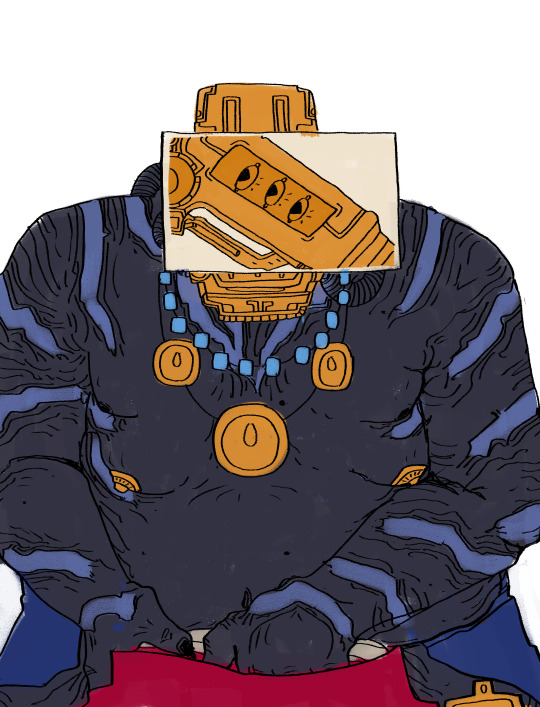

My complex thoughts and emotions about ancients cleverly discuised as ocs....
#rain world#rain world ocs#rain world ancients#me when me when my uhm my little guys.....#also no you cant tell this was a comic i gave up on no its not dont worry about it no worries 👍#!!#anyhow man its so fun to think about them huh#augh#my art#and we are listening to the bomb by florence ans the machine!#hmm to tired to make proper tags hmmm
2K notes
·
View notes
Text

filler
#xmen#xmen comics#cherik#charles xavier#erik lehnsherr#magneto#professor x#snap sketches#fun fact there was dialogue but as i was listening to music i found i liked it better without vjaLKJALK#at the very least the dialogue was just meant to allude to the fact charles just wanted erik to kneel down so he could give him a kiss#but using his wheels getting stuck as an excuse... like girl he didnt actually expect a rock to be there... lol ...#ive always wanted to try dialogueless comic/s anyhow.... so thats fun...#double fun fact i was actually going to abandon this. i got tired after the sketch fjERKLJJKAL#but then i lined the close up of mags and i was like Oh.. i must finish this so i can share THAT panel specifically#and ilke yeah i guess in review the whole thing's kinda cute... whatever.. I GUESS i like it..#i enjoy that about myself i liek how i'll dislike something and be Not Confident about it and then ill be like 'oh its ok acutally'#trust the process or whatever..#anyways. ive been drawing these two too lovey lately and magneto especially cuddly.. whats that about...#next time i draw them he's gonna be in charles' lap i swear. or killing each other whichever i decide#ANYWAYS. im gonna be meeting a friend later !!!!!!!!!!!! so exciting..#i cant wait to start working on the next comic i have in mind ... me hopes you all enjoy it#im gonna lock in for it so i prob wont post anythin for a while.. or at the very least it'll just be lil doodles#we'll see.... ANYWAY good night !!!!!!!
881 notes
·
View notes
Text

big fan of the new kids,,
#enstars#my art#fanart#ensemble stars#shu itsuki#mika kagehira#shumika#taki ibuki#ibuki taki#sagiri esu#esu sagiri#fuyume hanamura#hanamura fuyume#natsu kanna#kanna natsu#raika hojo#hojo raika#is that everyone?#4piece#i think#little doodle tag#anyway#i think it would be really cute if mika got along with all the new kids cause they remind him of the orphanage kids#that would be adorable#nice come collect your kids#before shumika swipe them up hashtag parenting#anyhow#i love the new kids theyre so cute oh my god#i have so many fun little drawing ideas for them#"oshisan can we keep em?' PLEASE SAY YES
1K notes
·
View notes
Text




last post for @cityfrightspm! woe. get spooky 💥💥
#project moon#limbus company#library of ruina#don quixote lcb#hong lu lcb#catherine lcb#angela lor#roland lor#YIPPY CHARACTER TAGS... couldnt go out for halloween so this will have to do ^_^ had fun anyhow hwehehe..#so cruel i cannot draw everything always all the time. alas =w=#also catqui bc i enjoy fun and whimsy. woe <33
438 notes
·
View notes
Note
hope you feel better soon!

I am riddled with ailments, but I stay silly!
#ask#non mdzs#My health journey has been: Hernia -> acid reflux -> Vocal pain due to aforementioned reflux -> chest infection.#I'm terrified to know what's about to hit me next. Please let it be something kind. PLEASE.#The consequence of living with linguists is that you'll wake up with a wacked up voice -#suddenly you're sitting you down in front of a program called something like Praat having your shimmer and jitter levels calibrated.#They gave me a GRBAS of 33012. I have a fun thing called a pitch break where a whole octave just does not exist.#My vocal pain was bad enough I ended up seeing a speech pathologist and that whole experience was super neat!#I learnt a lot about voice - to be honest I might make a little comic on it after some more research. Fascinating stuff.#For example; your mental perception of our voice modulates the muscles of the vocal folds and larynx.#meaning that when you do have changes (inflammation = more mass = lower frequency)#your brain automatically attempts to correct it to what it 'should sound like'. Leading to a lot more vocal strain and damage!#And it gets really interesting for trans voice care as well - because the mental perception of one's voice isn't based on an existing sampl#So a good chunk of trans voice training is also done with the idea of finding one's voice and retraining the brain to accept it. Neat!#Parkinsonial Voice also has this perception to musculature link! The perception is that they are talking at a loud/normal volume#but the actual voice is quite breathy and weak. So vocal training works on practicing putting more effort into the voice#and retraining the brain to accept the 'loud' voice as 'normal'.#Isn't the human body fascinating?#Anyhow; Now I have vocal exercises and strategies to reduce strain and promote healing.#Which is a lot better than my previous strategy of yelling AAAH in my car until my 'voice smoothed out'.#You can imagine the horror on the speech path's face. I am an informed creature now.#I'm my own little lab rat now. I love learning and researching. Welcome to my tag lab. Class is dismissed.#I'll be back later with a few more answered asks </3 despite everything I'm still going to work and I need the extra sleep.#Thank you for the well wishes! And if you read all of that info dump; thank you for that as well!
438 notes
·
View notes
Text

secret samol for @stablecrayon Pickman looking cool!
#secret samol#secret samol 2024#ernestine pickman#sangfielle#pickman#i drew her whole armour#then realized it messed w the composition#anyhow this was soooo fun#artings
171 notes
·
View notes
Text


🌻Vanne🌻
Some of the finished art from yesterday’s video, where I designed a couple of Genshin Impact OCs! (And finally got to reveal one of the secret projects I've been working on...! 👀) I’m gonna be posting the finished pieces here throughout the week ahead; so first up is this sunny Dendro/Claymore wielding farmer from Mondstadt! 🌻
[DO NOT EDIT OR REPOST TO OTHER SITES / ACCOUNTS] ♻️reblogs are lovely tho!♻️
#artists on tumblr#abd illustrates#genshin impact fanart#character design#original character#trying out what its like to actually post multiple times a week instead of cramming everything into one post sgdhsf#we'll see how we do!#anyhow these were FUN
2K notes
·
View notes
Text
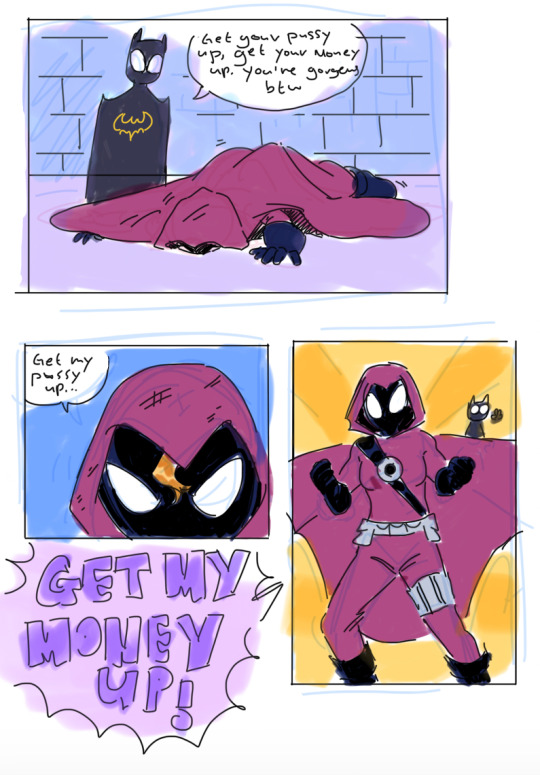
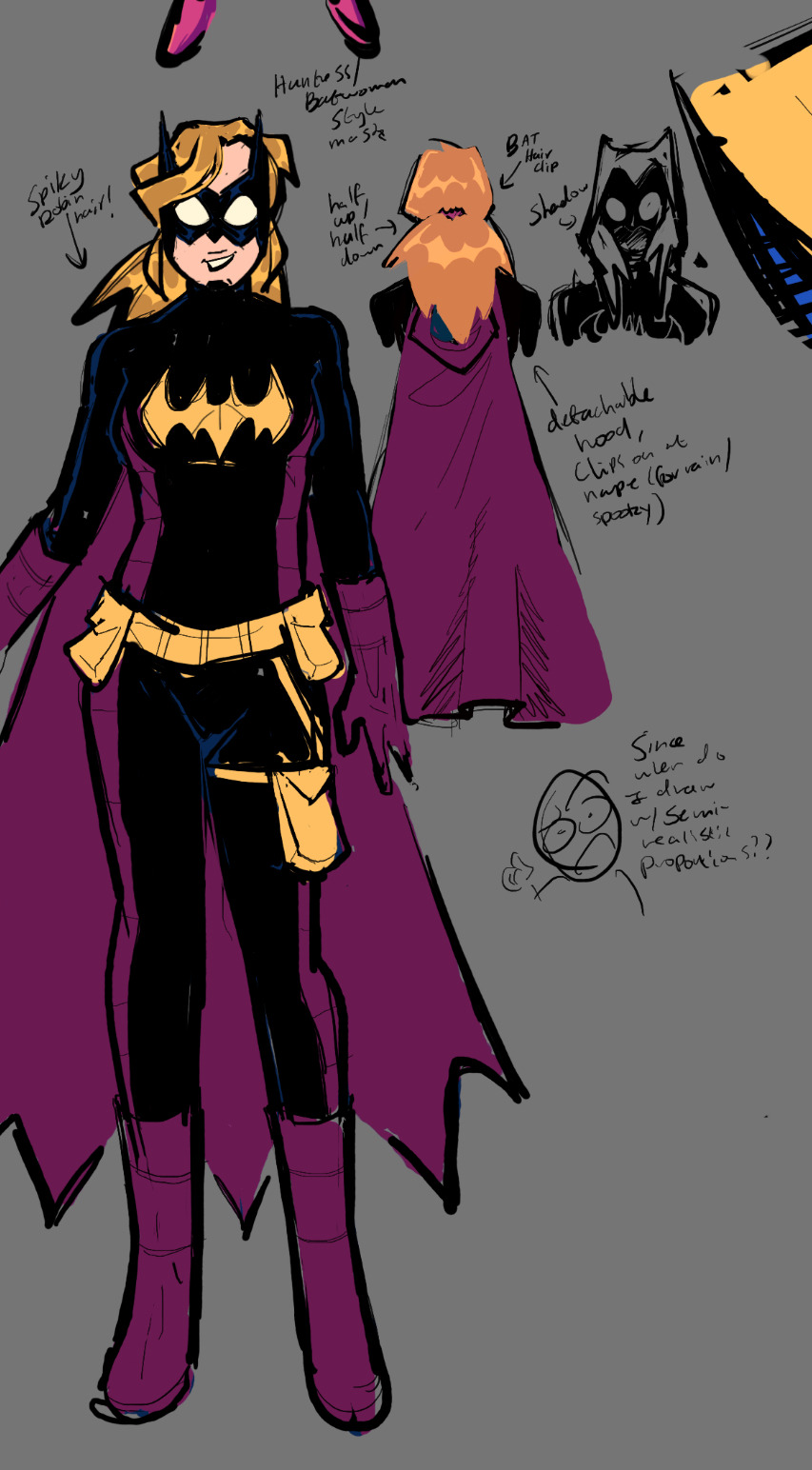



(ID in alt) I literally said I was gonna post this month's ago and then never had the wherewithal to describe it and so I didn't Lmao (said with pain). But since I'm thinking of opening my commissions I figured I should remind ppl that I. Yknow. Can draw.
Lots of Steph here (I had major art block making all of these and my brain worms for her kept me going) + some sprinkles of stephcass for Cass nation to enjoy!
#dc comics#dc#stephanie brown#cassandra cain#jason todd#(yes for the teddy bear. it counts)#batgirl#batgirls#mine#< keep forgetting to tag my art as that I'm terrible 😭#ANYHOW I'm slowly getting back into drawing again after my last ipad got nuked (cant think abt that or ill cry) and i finished uni#oh yeah j finished my first year of uni btw. i went to an Olivia Rodrigo concert like a week or 2 ago. I've been busy lol#but yeah it's looking like I've got a fun summer of bottom feeding ahead of me now that I've officially been told i got passed over for that#-comic job i applied for. lol. lmao even#it's fine honestly it was a pretty daunting prospect i just have to find a way to fill the time by myself now#I've plenty of comics to read so that's nice. got wayyy into mark waids DD run recently (mostly for Chris Samnee's art)#so that's been fun! i have my empowered omnibus (embarrassing and kept under my bed <3) i have TT year 1 i have huntress and WW#uhhh i got flash 1 minute war. lots of good stuff!#so hopefully i don't go. completely feral from lack of stimulation#also hopefully commissions will be a thing i can do#godddd there's many mkre things i want to draw. i got too enamoured w my own bad theory and now I've drawn tim!bats#but unfortunately now i only want to draw tim!bats being laughed at my the batfamily bc seriously tim?? really??#< it's literally probably not going to happen but I've invested myself in this terrible future for some reason#imagine damian trying to robin for tim!bats for 1 (one) night and the next morning he doesn't say anything he just moves to bludhaven#he can't take this shit#oh so many ideas...#ANYWAY. ues. finally art. now if you like it. consider commissioning me (in 2 to 3 business weeks <3)#(no pressure)
424 notes
·
View notes
Text
It’s fucking done. Say gex everyone…
(A suggestive photoshoot, only cause I literally can’t give them sexual organs)










I did this with the precog D-16 and Orion Pax Yolopark figures. Took the pics on my iPhone and tweaked them with basic photo editing. I’m actually quite proud, I’ve been meaning to do this for a while. And yes I did get all hot and bothered while doing this. What is wrong with me lol.
#dpax#megop#transformers#valveplug#toy photography#d-16#Orion pax#tfone#tf one#transformers one#I speak?#ended kinda d centric but he’s beautiful so so what#kinda fun lol#satisfying anyhow#I’m so hot and cool and sexy#cool transformers artists please notice me#shyly ats people maybe? debating
144 notes
·
View notes
Text


The boys are hereee. More buggy au refs
#these are all so low effort#buttt im too tired to care. motivation isnt abundant rn anyhow#anyway. kinger was fun to draw#hes so... silly#goober if you will#rhinoceros beetle kinger#buggy au kinger#mosquito jax#buggy au jax#tadc buggy au#tadc au#fyp#for you#my art#tadc#bugs
276 notes
·
View notes
Text
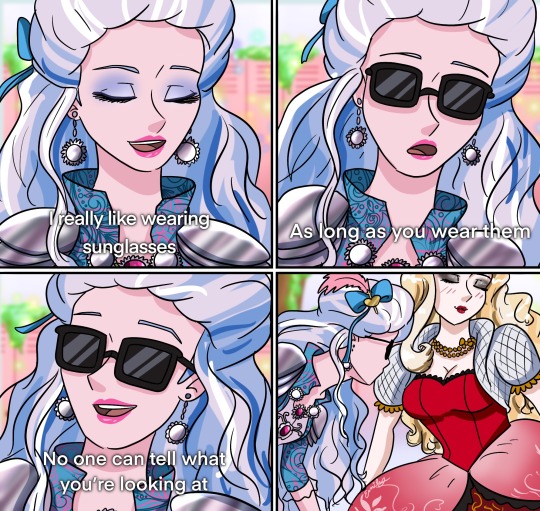
I’m not the biggest Darling fan but this meme had such her vibes lol
#sometimes you just have to do ship art for things you don’t ship lol#it was fun anyhow lol#I used to like Darling when I was little and I still think her design is fun#I just don’t love her with Apple#but anyway lol#ever after high#ever after royal#eah#eah fanart#apple white#eah apple#eah darling#darling charming#eah ships
889 notes
·
View notes
Text




rain world if it was hot
#rain world#rainworld room polls ending got me drawing rw rooms in a daze#its fun tho. rain world rooms are fun and shapes :)))#!!#my art#reccomending looking like you just woke up by the front bottoms today me thinks :)#anyhow didnt have to much to say!#oh wait i did uh yeah jumpscare im alive and posting stuff today becasue it felt awkward to post 3 days in a row instead of 3 at once#so uh like enjoy that maybe if you like that or dont i dunno up to you#thumbs up: thumbs up: thumbs up:
545 notes
·
View notes
Text






every character gets their own cute little PNG next to their textbox :3
#chatterbox#CRPED VN#toby gets a hatchet duh#jeff gets a knife and clocky a clock#what does jack get.... a jar of ominous red liquids?#idk abt nina either. probably a bow#kates gonna get a rock. im sorry. unless you can come up with a better idea but rock is funny#or crumpled paper...#ann will get a syringe#lulu will get gloves or an icecube or smth#lazari gets cookies idk why but she gets a cookie#dina gets a cross necklace#jane gets a magnifying glass or a pearl necklace or newspaper#hopefully i can find a good striped scarf png for liu..dunno what else i would give him anyhow#office paper maybe#sally will probably get little bobby socks cuz i gave y/n a teddy bear#ben gets a game cartridge or gameboy DUHHHHHHH#why is assigning them objects so much fun omfg#creepypasta
112 notes
·
View notes
Text




some gitm sona doodles (because we wanted to practice drawing them and because we need to cope)
gitm is of course by @venomous-qwille (feel free to ignore this sorry!)
closeups under the cut:



#minute doodles#not my au#minute sona#uhh sorry they're just very neat fellows I couldn't help myself#(also I've never drawn them before so. I sincerely apologize)#I'm going to be honest I could never really see myself as cricket just because of the huge differences between personalities#I think I'd act very differently if I were in their place#but anyhow this was fun I'm going to burn it to ashes later if I remember#delete later#posting this on a weekday so no one sees it#gitm au#(we can tag it like that yes?)#anyhow wuhh#I think I could! Maybe? Get along with them?#we're moderately good at embroidery and pretty good at crocheting so#maybe sol won't destroy our self-esteem#sunspot is very sweet#i would love love love fool and misuta with all my heart and soul because#THEATRICS! and LITERATURE! and RAMBLING OPPORTUNITIES!!#(not me dropping to much literary interp / historical knowledge in the conversation)#(but. maybe they'd be able to build off of it!)#so. yknow!
129 notes
·
View notes
Text

dipping my foot into the fandom with some outfits for they :)
#batman#tim drake#cassandra cain#stephanie brown#ough posting arts everyones favorite and hitting it off with such bangers as contextless lineups :thumbsups: i have to force myself to actu#tully draw them someonhow. otherwise id just imagine drawing them for the 100000ths time. its fun tho :))#(nno you cant totally tell its my first time drawing them)#anyhow just some notes cause i like sharing!#forever torn about casses clothes because i am at war with if shed only wear practical clothing with no excees clothing to always be prepar#d for a fight or to go with more comfy clothes because shes finally free and settling in with the reality that she dosent always need to fi#ht#stephs a bit to pastel but i think she should get to have fun she needs it my babygirl is unwell probably but im sure a cute shirt and funk#bracelets will fix her#also please apprictae tims shitty tshirt its so silly to me#also yes skating protective gear and while i think he also wouldnt use them its also so funny to me so like fight me you know#anyhow!#the giirrrllllsss (plus tim)
160 notes
·
View notes